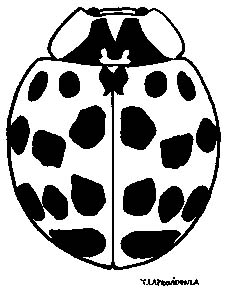Multicolored Asian Lady Beetles
EN021 (6/02)
Multicolored Asian Lady Beetles:
Turning a Pest into a Resource
By Kimberly A. Stoner
Department of Entomology
The Connecticut Agricultural Experiment Station
123 Huntington Street
P.O. Box 1106
New Haven, CT 06504-1106
Telephone: (203) 974-8480 Fax: (203) 974-8502
Email: Kimberly.Stoner@ct.gov
and
Kathy Caruso
Certified Organic Farmer
Upper Forty Farm, Cromwell
 Since 1995, the multicolored Asian lady beetle (Harmonia axyridis) has been a familiar presence around our houses, congregating on the outside of buildings in mid-October, aggregating inside during the winter, and reappearing as the days get longer and warmer in the spring. For most of us, these beetles are a curiosity or an annoyance, but for a few people who get large aggregations in their homes each year, they are pests.
Since 1995, the multicolored Asian lady beetle (Harmonia axyridis) has been a familiar presence around our houses, congregating on the outside of buildings in mid-October, aggregating inside during the winter, and reappearing as the days get longer and warmer in the spring. For most of us, these beetles are a curiosity or an annoyance, but for a few people who get large aggregations in their homes each year, they are pests.
However, this lady beetle, like many of the other familiar lady beetles, is a voracious feeder on aphids, scale insects and other plant pests. So, in an agricultural context, both the larvae and the adults are effective biological control agents.
This article is about the methods used to collect, store, and release lady beetles in the greenhouse for biological control of the aphids the following spring.
Collecting: The best opportunity to collect large numbers of multicolored Asian lady beetles as they prepare to go into dormancy is to catch them in middle to late October as they aggregate on the outside of buildings. At a good site, one person can collect more than 100 lady beetles in 1½ hours. The best sites are light-colored buildings facing south or southwest. Beetles aggregate on sunny afternoons beginning about October 15. The easiest collecting method is to lightly dust the inside of a glass jar with flour, and knock beetles into the jar. The flour sticks to the tarsi (feet) of the beetles and prevents them from being able to walk up the sides of the glass. Very few of them try to fly out of the jar without walking up the glass first.
Handling: As soon as possible, transfer the beetles to new, clean jars with clean paper towel to walk on, so that the beetles can clean the flour off themselves. Then, provide slices of banana for the beetles to feed on. They will feed vigorously for a few days. The bananas give them carbohydrates and moisture, which help the beetles survive winter dormancy. (Commercial lady beetle food is more expensive and no more effective than bananas. Aphids would be another potential food, but it is difficult to find adequate numbers of attractive species in October. Cabbage aphids, an abundant species in the fall, were not attractive.)
Storage: For good survival, it is best to store the lady beetles under cold, humid conditions. An old refrigerator that is not self-defrosting is suitable, as is a cold room for storing produce, as long as the temperature is maintained at a constant 39 degrees F. with close to 50% humidity. Survival of the fall-collected multicolored Asian lady beetles was close to 100% under these conditions. Survival was reduced in a basement storage room with more fluctuating temperatures. Also, modern frost-free refrigerators have a lower level of humidity and may dry out the beetles too much.
Use in the greenhouse: Based on greenhouse experiments, multicolored Asian lady beetles can be managed to control aphids. If the greenhouse vents are not screened, the lady beetle adults must be kept confined in insect cages so they do not escape. Aphid-infested plants are put into the cages and changed at least weekly (sooner if the aphids are all gone). The beetles feed on the aphids (An adult will eat 90 to 270 aphids per day.) and lay egg masses on the the plants. Adding banana slices to the cages increases the numbers of beetle egg masses slightly. When the plants are removed from the cage, the beetle egg masses are clipped off the plants and distributed around the greenhouse. It is very important to change the plants frequently and re-distribute the egg masses because lady beetle larvae are highly cannibalistic and adults will also feed on egg masses. Spreading them out gives the lady beetle larvae more opportunity to feed on the pests instead of on smaller stages of their own species. Lady beetle larvae will not easily escape from the greenhouse because they do not fly. Each larva will eat from 600 to 1,200 aphids during its development.
Thus, if you have a suitable cooler or old refrigerator you can harvest and use the multicolored Asian lady beetle as an effective aphid predator for the cost of a few insect cages, some bananas, and a few hours collecting the beetles in the fall.
Summary
Since 1995, the multicolored Asian lady beetle (Harmonia axyridis) has been a familiar presence around our houses, congregating on the outside of buildings in mid-October, aggregating inside during the winter, and reappearing as the days get longer and warmer in the spring. For most of us, these beetles are a curiosity or an annoyance, but for a few people who get large aggregations in their homes each year, they are pests.
However, this lady beetle, like many of the other familiar lady beetles, is a voracious feeder on aphids, scale insects and other plant pests. So, in an agricultural context, both the larvae and the adults are effective biological control agents.

